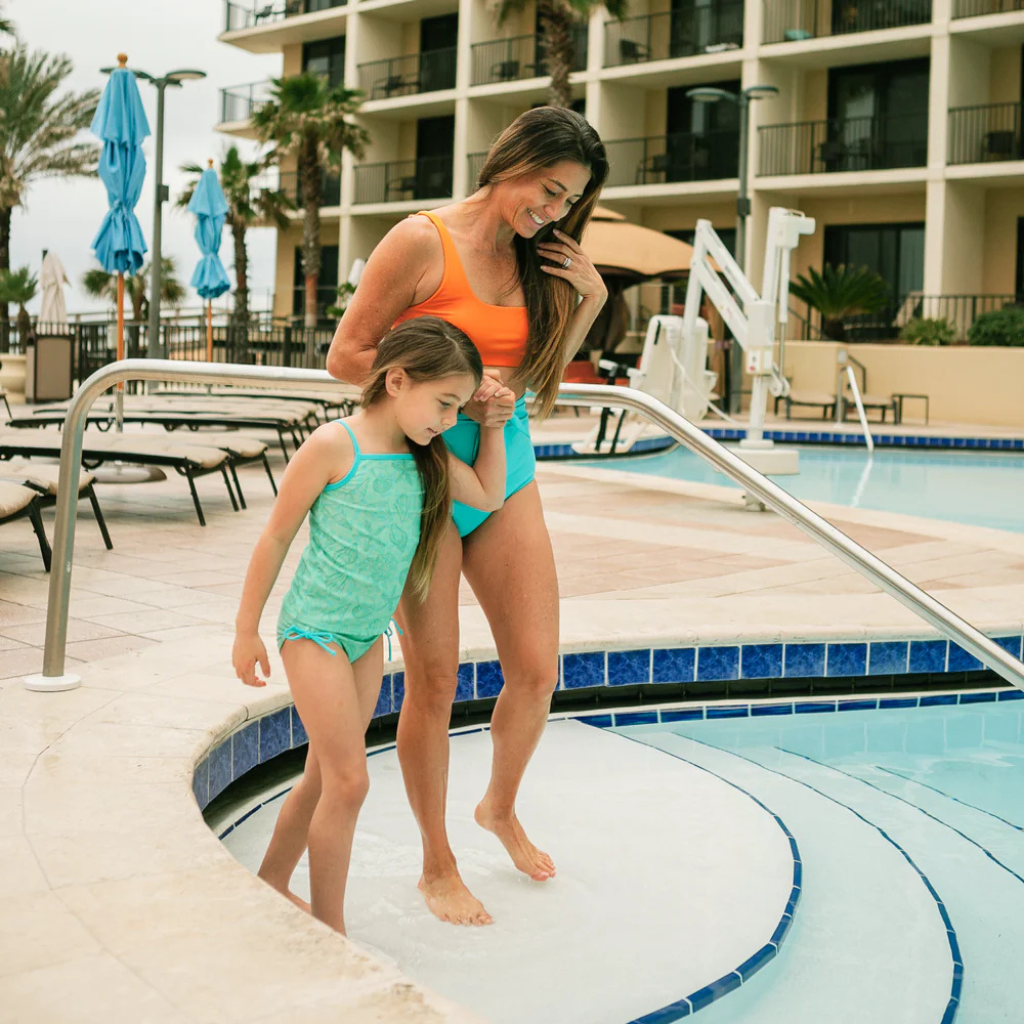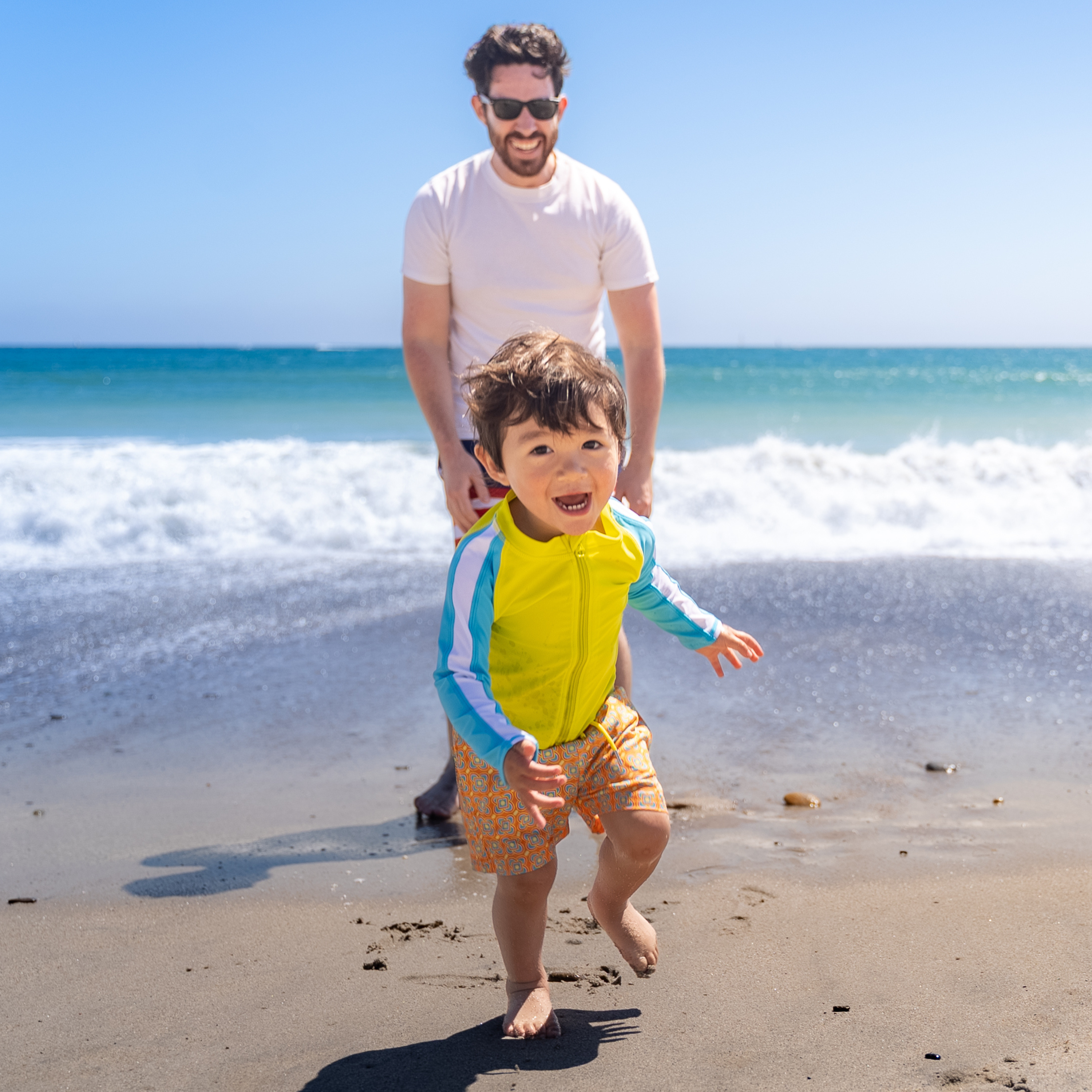
What do I need for my kid's first swim lesson?
Your child's first swim lesson is a big milestone. It's exciting, a little nerve-wracking, and something you'll both remember. The best way to make it go smoothly is to show up prepared with the right gear, the right mindset, and a little extra patience.
We’ll guide you through everything you need to pack, what to expect, and how to make the first day in the pool a fun experience for you and your child. We'll also highlight some SwimZip favorites so your little swimmer is comfortable, safe, and smiling.
Before the Lesson
Parents often think the most important step is showing up, but much of the success of the first swim lesson happens in advance. A little preparation is the difference between a smooth, confident start and a stressful, tear-filled morning.
- Check swim school policies: Some pools require swim diapers, others ban goggles, and many enforce strict arrival times. Call ahead to avoid surprises.
- Talk with your child about what to expect: Kids perform better when they know what's coming. Use simple language, frame it as fun, and reassure them that their instructor keeps them safe.
- Build water confidence at home: Let them pour water over their own head during bath time. Practice blowing bubbles in a cup of water. Count to three together while they hold their breath. These activities remove mystery from water interaction.
- Pack early: Rushing out the door adds stress for both of you. Get the bag ready the night before so you start the day calm and confident.
If your child shows fear or resistance, acknowledge their feelings without dismissing them. Say "It's okay to feel nervous" rather than "Don't be scared." Tell them what to expect: "The teacher will show you how to kick your feet and move your arms."
Children mirror your energy. So stay organized and relaxed to help them approach the pool with the same mindset.
Your swim bag checklist
Missing the right gear leads to frustration, discomfort, or sitting out of class. Confirm exact requirements with the swim instructor, but here is a swim bag checklist that will get you through the first lesson and set your kid up for success.
1. Swimsuit
Get a snug, comfortable swimsuit. Loose or baggy suits distract kids and restrict movement in water. A well-fitting suit builds confidence and mobility. Get a pair of swim shorts or swim trunks for boys and a one-piece swimsuit for girls. If the water or air temperature will be cool, add a long-sleeve rash guard for comfort.
Don’t just pick your child’s favorite color. Some colors blend into the pool floor and walls. Instead, pick a high-visibility swimsuit so you and the instructor can easily track your child.
👉 Try our kids’ sun protective swimwear with UV protection. They offer comfort, chlorine resistance, and adorable prints your child will love.
2. Swim diaper (for toddlers and non-potty-trained kids)
Swim diapers are mandatory for younger children. Pools will turn families away without one. Even if your child is nearly potty-trained, accidents happen, and most swim schools enforce strict diaper rules.
Pack a backup swim diaper as well. Better to have it and not need it than be stuck without one.
3. Swim goggles
Some kids love dunking their faces in water. Others find it terrifying. Swim goggles help children of all confidence levels get comfortable in the water and avoid chlorine discomfort. Look for anti-fog lenses and soft straps that don't pinch.
👉 Check out kids’ sunglasses for coordinated sun protection out of the water.
4. Swim cap or hair ties
Long hair in the face makes swimming hard and frustrates kids. Swim caps or hair ties eliminate distractions. Caps also help pools stay clean. If your child has medium to long hair, keeping it contained improves focus and comfort.
5. Towel or hooded towel
Kids actually find it uncomfortable to get out of the pool. They're cold, dripping, and ready to snuggle. A soft, absorbent towel (especially a hooded one) makes transitions smoother.
6. Flip-flops or pool shoes
Pool decks are slippery and full of germs. Flip-flops or pool shoes keep feet safe and make bathroom trips easier.
7. Change of clothes
After class, kids don't want to sit in damp swimsuits. Dry clothes help them warm up and transition back into the day.
Pack extra underwear. It’s the most forgotten and most important post-lesson item.
8. Hydration and snacks
Swimming burns a lot of energy. Kids come out of the pool thirsty and hungry. A water bottle and a small snack prevent meltdowns and restore energy.
Think of snacks as part of the lesson plan. They reset energy and mood.
9. Sunscreen and UV swimwear
For outdoor lessons, sun protection is a must. Broad-spectrum sunscreen works, but UPF swimwear provides reliable, lasting protection without constant reapplication. For outdoor lessons, outfit your child in a long-sleeve rash guard and cover their remaining exposed skin with sunscreen.
10. Optional extras
Some kids have unique needs. Earplugs help those prone to ear infections. A nose clip comforts kids who are sensitive to water in their noses. A wet bag for soggy swimsuits or travel-size shampoo for a quick rinse keeps you organized and your child clean.
Customize your bag to your child's quirks or comfort items. If your kid is at ease, the lesson will go a lot smoother.
What not to bring
You want to bring the essentials and extras that comfort your child, but parents often overpack. Too many extras clutter the pool deck and get in the way. Leave behind:
- Floaties or inflatable toys: Instructors discourage them. Lessons focus on body positioning and safety skills.
- Bulky clothing: Keep it simple with a swimsuit and towel.
- Extra toys: Unless allowed, they distract more than help.
On the day of the lesson
The morning sets the tone of the lesson. Chaos and haste cause anxiety, while a calm routine reassures your kid.
- Arrive early: Get to the lesson 15 minutes early so your child can adjust and observe before diving in.
- Bathroom first: A last-minute rush mid-class stresses everyone.
- Gear up ahead of time: Put on swimsuits and swim diapers at home. Add goggles and caps at the pool.
Practice patience to manage your child’s first-day jitters. If your child clings to you or starts crying, stay calm. Acknowledge their feelings: "I see you're feeling nervous. That's okay." Avoid promises you can't keep, like "It won't be scary" or "You'll love it right away." Instead, focus on what they can control: "You can hold my hand until we meet your teacher" or "We'll go slow and see how it feels."
Some children benefit from watching other kids in the pool before their turn. If you arrive early, let them observe a class in progress. Point out how the other children are smiling and having fun. This normalizes the experience and reduces anxiety about the unknown.
After the Lesson
Kids leave the pool tired, hungry, and oftentimes unsure about how to process the experience. Set up a routine that addresses your child’s needs and wants after the lesson.
- Rinse off: A quick rinse removes chlorine and keeps skin healthier. Learn more about how to wash swimsuits to maintain UPF protection.
- Warm up: Dry towel and clothes restore comfort.
- Refuel: Snacks balance energy and mood.
- Celebrate effort over perfection: Focus on bravery and trying new things rather than skill mastery.
Process the experience to build excitement for future lessons. Ask open-ended questions, like "What was your favorite part?" or "What did you learn today?" Avoid asking "Did you have fun?" which pressures them to respond positively. Let them share their own feelings and observations.
If the lesson didn't go as planned, resist the urge to apologize or promise it will be different next time. Simply acknowledge what happened: "That felt hard for you today," and reassure them that learning takes time.
End the day positively to make kids eager to return.
SwimZip picks for first swim lessons
We know first lessons can be stressful. That's why we design gear that makes the day easier. Our patented zipper technology makes changing in and out of swimwear a breeze, and our swimwear holds the Skin Cancer Foundation's Seal of Recommendation for high-quality UV protection.
- Kids' swimsuits with UPF 50+: Fun designs, zipper closures for quick changes, and all-day comfort.
- Long-sleeve rash guards: Extra sun protection for outdoor pools.
- Sun hats: Complete protection for pool deck time.
- Family matching options: Coordinate with your kids to give them a confidence boost.
Swim gear should make life easier. SwimZip products combine comfort, safety, and trusted sun protection, so parents can focus on cheering from the sidelines while we keep the sun off their children’s backs.
First swim lesson FAQ
Do kids need goggles for their first lesson?
Not always. Goggles help nervous swimmers feel more comfortable putting their faces in the water, and some swim schools require them.
What's the best swimsuit for a first swim lesson?
A snug, comfortable one-piece or rash guard set works best. Avoid loose fits that slow your child down. Look for girls’ sun-protective swimwear or boys’ sun-protective swimwear with UPF 50+ protection.
How early should I arrive before a swim class?
Arrive 15 minutes early. This gives you time to change your child, settle their nerves, and meet the instructor.
What if my child is scared of the water?
Children are often water-shy. Stay calm, offer encouragement, and let the instructor guide the process.
Can I get in the water with my child?
Parent-and-child lessons welcome you in. Independent lessons may ask you to watch from the side. Check with your swim instructor to understand expectations.
How do I keep my child warm in a cold pool?
A snug rash guard top adds warmth. Have a towel and dry clothes ready right after class.
What should I pack for after the lesson?
Dry clothes, a snack, and water. A wet bag keeps gear organized and prevents a mess.
How much do swim lessons cost?
Group lessons typically range from $15–40 per session, while private lessons can cost $50–100+. Many facilities offer package deals or monthly memberships that reduce per-lesson costs.
What if my child is afraid of the instructor?
It’s normal for children to fear strangers. Give it a lesson or two. Kids often warm up once they realize the instructor is kind and patient. You should also interact with the instructor to show your child that they are friendly. If fear persists, discuss switching instructors with the swim school.
Should I bring my phone or camera?
Check the facility's policy first. Many pools prohibit photography for privacy reasons. Even if allowed, resist the urge to document everything; support matters more than getting the perfect shot.
Further reading
What is the best color swimsuit to wear in the pool?
How to keep kids safe at the pool
How do I protect against drowning?
How to pack a girl’s beach bag
How to fix a swimsuit that’s too small
Resources
Richard, E. G. (n.d.). Sun Protective Clothing. The Skin Cancer Foundation. Retrieved September 18, 2025, from https://www.skincancer.org/skin-cancer-prevention/sun-protection/sun-protective-clothing/



Leave a comment
This site is protected by hCaptcha and the hCaptcha Privacy Policy and Terms of Service apply.